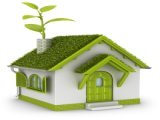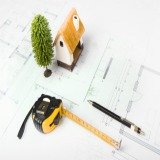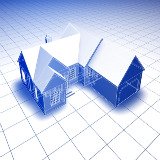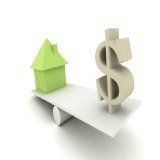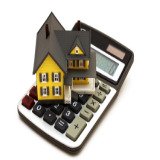Green Home Designs
Green home designs are becoming very popular as more homeowners make an effort to minimize the resources and energy used in the home. These green house designs involve a number of different categories that can be included to make your home more environmentally friendly.
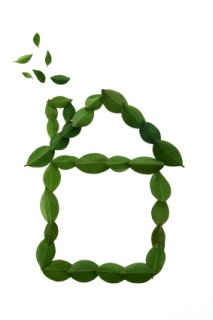 This type of green home design requires significant advance planning usually, because components and factors such as site analysis and home
orientation are the first steps to building a home which is as green as possible. These steps must be taken before construction even starts.
Conserving resources and utilizing them efficiently is also important with green home plans, and these homes are also very energy and water
efficient.
This type of green home design requires significant advance planning usually, because components and factors such as site analysis and home
orientation are the first steps to building a home which is as green as possible. These steps must be taken before construction even starts.
Conserving resources and utilizing them efficiently is also important with green home plans, and these homes are also very energy and water
efficient.
The purpose of green house designs is to create a home which requires fewer resources and less energy, and a combination of methods and techniques are used to achieve this goal. Landscaping, storm water management systems, home orientation / placement, and even the ideal window placement can make a big difference in the amount of energy use.
Home plans which are green will minimize the amount of cooling that is needed in the warmer months, and maximize the heat collected and retained in your home during the winter months.
Lot Design, Preparation, and Development with Green Home Designs
The design, preparation, and development of your lot is one of the essential components for green home designs. Your site will need to be surveyed, and the best possible location determined. You will need to examine and evaluate the area of the site where the sun will rise in the morning and set in the evening, so you can take advantage of these factors in the design and location of the home.
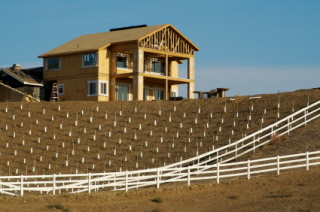
Look at the vegetation of the site, and at any available tree cover. Trees which are very full in the summer but that have no leaves in the winter months can provide shade in the hot months and allow the winter sun to reach the home for warmth during the cooler seasons.
Once you have determined the best location for your home, then you will need to consider the orientation for your green home design which is the most effective. The best choice is to have the sides of the home which are shortest face to the west or east, while the longest sides of the home should face north or south.
The lot preparation and development should consider natural barriers and resources that are present on the lot. A hill can provide a great heat barrier. Vegetation can be used to increase energy efficiency in all seasons when used properly.
Green Home Designs and Resource Efficiency
One of the benefits and goals of green home designs is the effective way that resources are used, and how these homes minimize the resources required. Effective resource management not only helps the environment but also benefits you as the homeowner as well. Fewer resources used means less costs. Natural heating and cooling resources are included in these designs as much as possible, because this lowers your energy costs.
Your home orientation should allow for any breezes during the warmer months, to increase air circulation and comfort levels in your home. This will minimize the resources needed to heat and cool your home. In a green home no resources are wasted, and the natural resources that are available are used to the fullest potential, which is one of the reasons they're so environmentally friendly.
Sensitive areas of the lot should be protected with any green home design, and slope disturbance should be minimized as much as possible. The natural resources of the site are conserved, and any possibility of soil erosion is kept as low as possible.
Landscaping designs and plans should be implemented which requires less water and fewer resources, but which add to the natural beauty of the site. Every aspect of the lot planning and development should be done with the goal of disturbing the environment as little as possible, and preventing or minimizing any waste and energy use.
Energy Efficiency in Green Home Designs
Energy efficiency saves the environmental impact on the earth, and the financial impact on your monthly budget planning. Green house designs should include energy conservation and efficiency concerning water, heating and cooling, insulation, and the lighting factors. Insulation should be used in as many places as possible, to minimize any heating or cooling loss and prevent outside air from entering the home.
Lighting is another area where energy efficient methods can be used to use less energy. Occupancy sensors and low energy lighting options can help ensure you get the light you need, without wasting any energy or seeing higher utility costs.
Solar and heat pump water heaters can be installed to conserve energy while providing hot water in green home design plans. Staggered window placement can also be used to lower the energy needs of your new home. Windows which are placed on more than one level will allow fresh cool air into the home on the lower level, and the heated air is forced out of the windows on the upper levels.
This keeps your home cooler in the summer months without any energy use, and this method is commonly used in homes where energy efficiency is desired. This will help lower the operational costs of the home's mechanical systems, and conserve energy.
Factors Involved with Green Home Designs and Water Efficiency
Green home design will implement water recapture and runoff management procedures and systems, so that they're extremely water efficient. Cisterns can be used to collect rainwater, which can then be utilized to water plants and landscaping. Storm water runoff can also be used for many cleaning purposes, and this lowers your water usage and your water bill.
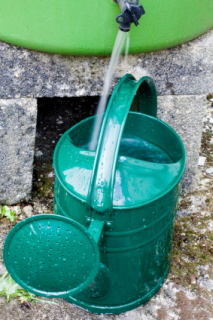
Many areas of the country suffer from drought conditions and dry weather for a significant part of the year, and water conservation can be legally required in some cities. The water use inside and outside the home will need to be considered, and steps taken to reduce this use can make your home much more green.
The efficient use of water in green home designs is also helped by appliances and accessories which help lower water use. An on demand hot water heater will ensure that you have hot water when you need it, without wasting energy keeping water hot until its needed.
A solar water heater can be utilized for hot water when there is plenty of solar energy available, and this reduces the use and cost of a traditional hot water heating system. Toilets that are ultra low flow use less water per flush and low flow shower heads can be installed to cut the water use down significantly while you shower.
Indoor Environmental Quality and Green Home Designs
One of the biggest reasons that green home designs have become so popular and in demand is that these homes have superior indoor air quality when compared to other types of homes. Many homeowners insist on a home that has excellent indoor air, and this is caused in part by increasing allergies and problems with the air quality in previous homes.
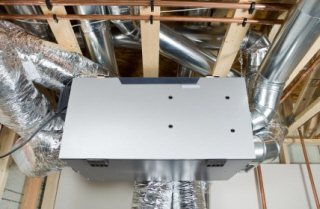
Any chemicals or other pollutants used during the construction process should be minimized if it is not possible to eliminate these components completely. Methods which can improve the air quality and environment inside your home can include mechanical ventilation systems, as well as omitting certain components or appliances which can cause air pollution in the home.
Preventing moisture is also important for the environmental quality in any green home designs. Moisture can lead to water damage and mold, both of which can cause air pollution and health issues. Any materials which are susceptible to moisture or molding should be well protected, and every effort should be made to prevent any moisture from entering your home.
Filters can be added to any heating and cooling units, and there are very effective HEPA filters which can remove many pollutants from the air on a continuous basis. Ventilation systems are used to circulate and filter the air in many green homes, and this can limit the allergy symptoms and other health issues you experience.
Landscaping and Green Home Designs
Landscaping is a big component with green house designs, but this is a component that many do not consider until after the home construction is completed. The types of plants and trees that you use around your home, and the environmental impact of the landscaping that you choose, can help make your home much more green.
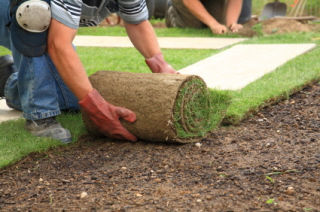
Trees can be used to provide shade, block any cold winter winds that could cause drafts and higher heating bills, and help keep the outside environment cleaner because of their purifying effects. Hedges and bushes can be used to create a living fence, instead of destroying trees for this purpose.
Landscape planning should be part of the initial construction phase, so that it's included in the methods used to make your home green and environmentally friendly. Green home design can include the use of porous concrete for outdoor areas, because this material absorbs water and decreases the runoff during storms.
Plants which are drought resistant, native to your area, and do not require large amounts of water can help your yard look beautiful without wasting a lot of water. Collected rain water can be used to water your plants and trees, and this lowers your water use even further. Organic fertilizers and natural compost mixtures should be used instead of chemicals, to prevent any water contamination in the ground.
Building Operation, Maintenance, and Owner Education with Green Home Designs
Having a green home design is a great start, but it's also important that you understand the building operation and maintenance as a homeowner. Owner education should include advice on ways to prevent moisture buildup, as well as how to operate and maintain all of the systems included in your home.
All new green homes should include an owners manual which should include certain components and information. Tips and hints on steps that you can take to keep your home as green as possible should be listed, and diagrams that show all of the details of your home systems should be included in this guide. Information on recycling and renewable energy options should also be provided, as well as the operational procedures for all mechanical systems in your home.
Owner education is important with green house designs because ultimately the owner will be the one responsible for green living. The plans used to design and build this type of home are only part of the equation. You will need to understand what is expected of you as the owner, so you can minimize the impact of your home and activities on the environment.
Changing air filters when recommended, running exhaust fans in rooms where moisture is present, and choosing the best paints possible when repainting are all ways that you can make a green home even more environmentally friendly.
Key Elements
Positive Cost Features of Green House Designs
- Lower heating and cooling costs, because these designs utilize natural resources first
- Highly energy efficient, so less heating or cooling is needed to make the home comfortable
- A higher air quality can mean fewer allergy symptoms and lower health costs as a result
- Choosing the ideal location can impact all aspects of your home, and the related costs
- Solar water heaters do not require energy and provide free hot water when solar energy is available
- On demand water heaters reduce the energy used, because water is not heated until it is needed. This means lower water heating bills and financial savings
- Better water efficiency and lower water bills, because storm water and runoff are recycled and reused when possible
- Optimal landscaping reduces water costs without reducing the appeal of your home
- Moisture prevention will eliminate the risk of any mold, and the related costs to remove this harmful substance
- The use of resources is minimized, and renewable resources are used when possible
- Recycling and renewable energy use can lower the operation costs of a green home even more
Negative Cost Features of Green House Designs
- May initially be more expensive, but the reduced energy and water costs will offset this higher expense over time
- Solar water heaters may require a backup system for when solar energy is not available
- Filter changes can be somewhat costly if HEPA filters are used
You Might Also Like:
Home Design Floor PlansHome Design Floor Plans |
Green Home DesignsGreen Home Design |
Boat Home PlansBoat Houses |

